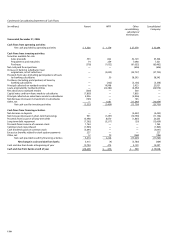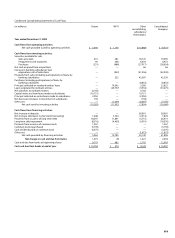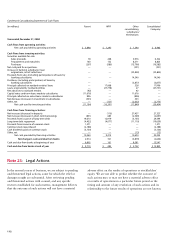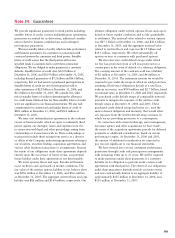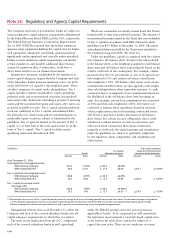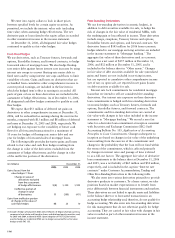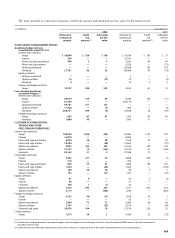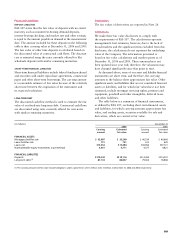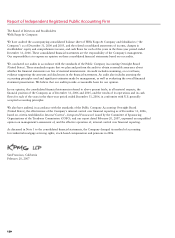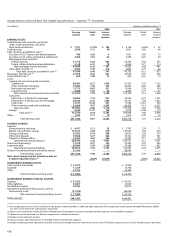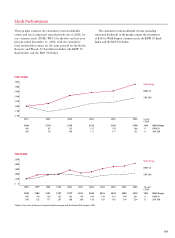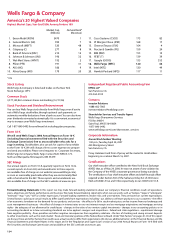Wells Fargo 2006 Annual Report Download - page 120
Download and view the complete annual report
Please find page 120 of the 2006 Wells Fargo annual report below. You can navigate through the pages in the report by either clicking on the pages listed below, or by using the keyword search tool below to find specific information within the annual report.
118
Note 27: Fair Value of Financial Instruments
MORTGAGES HELD FOR SALE
The fair value of mortgages held for sale is based on quoted
market prices or on what secondary markets are currently
offering for portfolios with similar characteristics.
LOANS HELD FOR SALE
The fair value of loans held for sale is based on what
secondary markets are currently offering for portfolios
with similar characteristics.
LOANS
The fair valuation calculation differentiates loans based on
their financial characteristics, such as product classification,
loan category, pricing features and remaining maturity.
Prepayment estimates are evaluated by product and loan rate.
The fair value of commercial loans, other real estate
mortgage loans and real estate construction loans is calculated
by discounting contractual cash flows using discount rates
that reflect our current pricing for loans with similar
characteristics and remaining maturity.
For real estate 1-4 family first and junior lien mortgages,
fair value is calculated by discounting contractual cash flows,
adjusted for prepayment estimates, using discount rates
based on current industry pricing for loans of similar size,
type, remaining maturity and repricing characteristics.
For consumer finance and credit card loans, the portfolio’s
yield is equal to our current pricing and, therefore, the fair
value is equal to book value.
For other consumer loans, the fair value is calculated
by discounting the contractual cash flows, adjusted for
prepayment estimates, based on the current rates we offer
for loans with similar characteristics.
Loan commitments, standby letters of credit and commercial
and similar letters of credit not included in the following table
had contractual values of $216.5 billion, $12.0 billion and
$801 million, respectively, at December 31, 2006, and
$191.4 billion, $10.9 billion and $761 million, respectively,
at December 31, 2005. These instruments generate ongoing
fees at our current pricing levels. Of the commitments at
December 31, 2006, 40% mature within one year. Deferred
fees on commitments and standby letters of credit totaled
$39 million and $47 million at December 31, 2006 and 2005,
respectively. Carrying cost estimates fair value for these fees.
NONMARKETABLE EQUITY INVESTMENTS
There are generally restrictions on the sale and/or liquidation
of our nonmarketable equity investments, including federal
bank stock. Federal bank stock carrying value approximates
fair value. We use all facts and circumstances available to
estimate the fair value of our cost method investments.
We typically consider our access to and need for capital
(including recent or projected financing activity), qualitative
assessments of the viability of the investee, and prospects
for its future.
FAS 107, Disclosures about Fair Value of Financial
Instruments, requires that we disclose estimated fair values
for our financial instruments. This disclosure should be
read with the financial statements and Notes to Financial
Statements in this Annual Report. The carrying amounts in
the following table are recorded in the balance sheet under
the indicated captions.
We base our fair values on the price that would be
received to sell an asset, or paid upon the transfer of a liability,
in an orderly transaction between market participants at the
measurement date. Our fair value measurements are generally
determined based on assumptions that market participants
would use in pricing the asset or liability and are based on
market data obtained from independent sources. However,
in certain cases, we use our own assumptions about
market participant assumptions developed based on the
best information available in the circumstances. These
valuations are our estimates, and are often calculated based
on current pricing policy, the economic and competitive
environment, the characteristics of the financial instruments
and other such factors. Therefore, the results cannot be
determined with precision and may not be realized in an
actual sale or immediate settlement of the instruments. There
may be inherent weaknesses in any calculation technique,
and changes in the underlying assumptions used, including
discount rates and estimates of future cash flows, that
could significantly affect the results.
We have not included certain material items in our
disclosure, such as the value of the long-term relationships
with our deposit, credit card and trust customers, since
these intangibles are not financial instruments. For all
of these reasons, the total of the fair value calculations
presented do not represent, and should not be construed
to represent, the underlying value of the Company.
Financial Assets
SHORT-TERM FINANCIAL ASSETS
Short-term financial assets include cash and due from banks,
federal funds sold and securities purchased under resale
agreements and due from customers on acceptances. The
carrying amount is a reasonable estimate of fair value
because of the relatively short time between the origination
of the instrument and its expected realization.
TRADING ASSETS
Trading assets are carried at fair value.
SECURITIES AVAILABLE FOR SALE
Securities available for sale are carried at fair value.
For further information, see Note 5.




